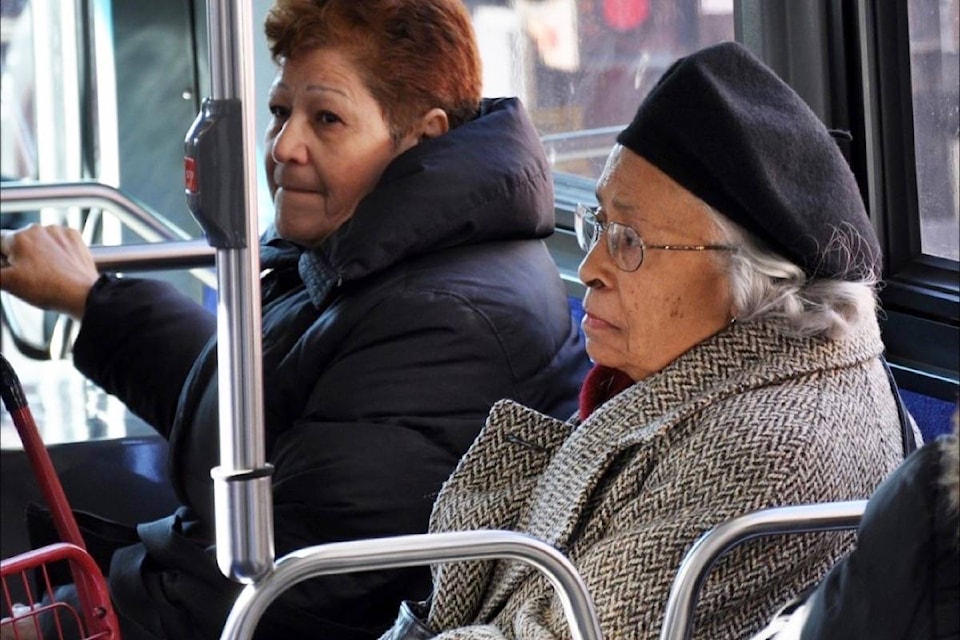Although transit systems like HandyDart and volunteer drivers are helpful in getting seniors out and about, the province’s senior’s advocate says there are still many gaps to fill to help with mobility for seniors in B.C.
Isobel Mackenzie’s office released a report Thursday highlighting the challenges that seniors face when trying to get around.
She pointed out that the challenges change from when a senior retires at 65 to when they are in the 80s and 90s. Their cognitive abilities as they age also play a factor, she said.
“When we retire at the age of 65, 90 per cent of us have an active drivers licence. We start our retirement lifestyle deriving to our activities and appointments,” said Mackenzie.
“We go from the majority of people have drivers licences to the majority of people not having drivers licences.”
READ MORE: B.C. seniors to get new driving assessment
Seniors who want to keep their drivers licences must complete a medical exam with their doctor.
The Driver Medical Examination Report is set to every driver in B.C. two months before their 80th birthday.
Although only five per cent of seniors have to then take an on-road test, the cost of it is often not covered by medical premiums.
There are two reasons to have to take the test: a known or suspected medical condition and the automatic 80th birthday test.
Doctors are reimbursed $75 for the former test but nothing at all for the latter.
Although the recommended fee is $92.20 for the in-office assessment and $205 for the road test, prices charged around the province can vary wildly and aren’t always waived for low-income seniors.
Mackenzie recommended that the province reimburse doctors for any kind of mandated road test and that they not be able to charge extra on top of that.
.@SrsAdvocateBC points out that when people retire at 65 y/o, the majority have drivers licences. However, by 85 only 44 per cent do, although the majority of those seniors are still living independently. @BlackPressMedia #bcpoli
— Kat Slepian (@katslepian) May 10, 2018
For those who stop driving as they get older, there aren’t always a lot of good options.
“At the age of 85, 44 per cent of people have a drivers licence but the majority people are still living independently,” said Mackenzie.
Although many major cities have well organized transit systems, seniors in rural cities are often stuck relying on friends, families and volunteers.
Mackenzie recommended that the province set up a “Community Drives” program using the same infrastructure as the province’s home support program for seniors.
The program would have trained drivers take seniors to appointments and activities, with a cost on par with other transportation options like transit.
Mackenzie said this was a better option than taxis, which are expensive and don’t have drivers trained to help seniors get in and out, fold up mobility aids and deal with cognitive challenges.
But even in cities with well designed transit systems, seniors struggle to take buses and SkyTrains.
“Picture someone who’s 87, with a walker, who hasn’t used a bus in years,” said Mackenzie.
She pointed out that even small changes like training bus drivers to ensure all passengers are seated before driving away from the stop could help seniors feel more confident using a bus.
Onto HandyDart. @SrsAdvocateBC says it works well for scheduled appointments, programs, weekly events. But if you just want to get to the library, or meet friends for lunch, it's much harder to book a spontaneous ride. @BlackPressMedia #bcpoli
— Kat Slepian (@katslepian) May 10, 2018
HandyDart, which run buses for seniors and those with disabilities, also had its challenges.
A round trip can cost $4-5, Mackenzie said, adding up to $40 a month for twice weekly trips, with no discounts for seniors making just $1700-2000 a month on a fixed income.
Mackenzie recommended charging an income-based fee for HandyDart to keep the system accessible to all seniors.
Like us on Facebook and follow us on Twitter.
